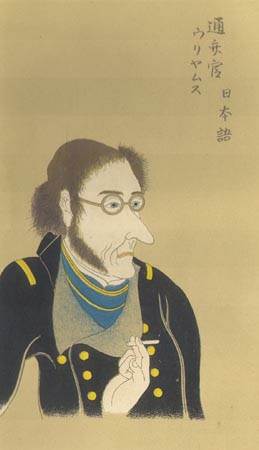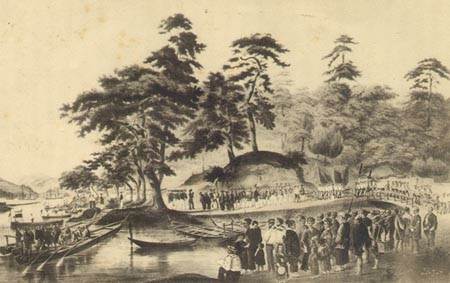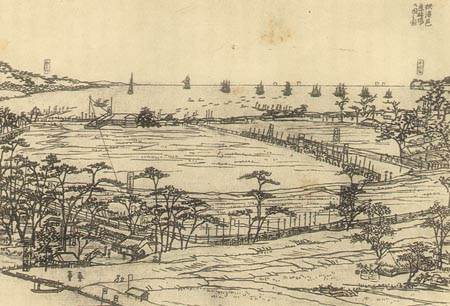Dr. Williams and the White Flag Controversy.
Controversy still swirls around Perry's presentation of the President's letter. It is known that in addition to the President's letter, Commodore Perry presented letters he had written. This is not disputed. However, in a recent junior high school textbook in Japan, it is asserted that Perry presented a letter and a white flag(s), threatening attack if the Japanese did not allow trade. Raising the white flag would be a signal to Perry that trade would be allowed. The historical support for this assertion is currently questioned and this has opened an academic debate know as the "White Flag" controversy. The support for this assertion appears to be founded only on a Japanese account of the letter (not the actual letter itself). Apparently the actual letter has not been produced nor is there a record of it in US historical records or documents. The "White Flag" letter is set forth in Meiji Japan through Contemporary Sources, 1844-1882, Volume 2, 1844-1882 (more information here), which was compiled and published by the Centre for East Asian Cultural Studies, The Toyo Bunko, Japan. The letter from Perry dated July 14, 1853 allegedly stated "If in such situation you seek for a reconciliation, you should put up the white flag that we have recently presented to you, and we would accordingly stop firing and conclude peace with you...." (Item No. II-C which is attributed to a 1910 publication). The same book presents a letter by Tokugawa Nariaki dated August 7, 1853. Nariaki was a staunch advocate of resisting, by military force if necessary, the American requests. In his letter Nariaki observed "The American barbarians who came this time were fully cognizant of our prohibitions, yet they arrived at Uranga, presented a white flag to signify the will to conclude peace, forcibly offered a request [for trade]...." (Item No II-E). Nariaki's account of the white flag is probably the most accurate. In his work titled "Passing the Rubicon," Wilhelm Heine depicts an American survey boat with a large white flag at the bow. This was during the period just prior to the first landing and presentation of the President's letter. Perhaps during the first landing a white flag was similarly shown (displayed) in order to demonstrate that the military forces landing did so with peaceful intentions. The letter dated July 7, 1853 from Commodore Perry is reproduced in the Narrative. However, this is not the "White Flag" letter.
Dr. Williams was the expeditions "first interpreter" and the man that Perry hand picked to be his advisor and interpreter. You would expect that he would be aware of the "White Flag" letter. You would expect that such a letter would have been mentioned or recorded by Williams. It was not despite the fact that in this private journal, Williams was often critical of Commodore Perry and the American tactics in general.
In the negotiations regarding the receiving of the President's letter one reference is made to a "white flag."
Friday, July 9th. ....The originals of the letter and credence were then shown to them [officials from Uraga headed by Yezaimon], and also a package containing the translations; they showed little or no admiration at them, but wished to know the reason for sending four ships to carry such a box and letter to the Emperor.... They were clearly informed of the meaning of a white flag, and also that visits were out of season til after the flags were hoisted in the morning. (at page 51)
In my opinion, this comment by Dr. William's does not support or buttress the basic proposition of the "White Flag" controversy. Just a few days later American survey boats were to be in Uraga bay under a white flag and it would seem reasonable to ensure that the Japanese understood the significance of the white flag. It does not seem reasonable that in the same sentence Williams would note the Japanese were admonished not to visit the ships too early in the morning and, by the way, if you don't show us a white flag we will unleash a major military attack.
Plates:
Cover of TASJ, Volume XXXVII, Part II, 1910
 Portrait of Commodore Perry with autograph of Sanjo
Nai-daijin, then Prime Minister, and Shozan Sakuma
Portrait of Commodore Perry with autograph of Sanjo
Nai-daijin, then Prime Minister, and Shozan Sakuma
 Frontispiece - Precedes the "Prefatory Note"
Dr. S. Wells Williams
(From a Japanese print of the period.)
Frontispiece - Precedes the "Prefatory Note"
Dr. S. Wells Williams
(From a Japanese print of the period.)
 After page ix, Follows the "Prefatory Note"
Title Page for S. Wells Williams Journal
After page ix, Follows the "Prefatory Note"
Title Page for S. Wells Williams Journal
 Commodore Perry's Landing at Kurahama, 14th July, 1853.
Commodore Perry's Landing at Kurahama, 14th July, 1853.
 After page 58
[Title is probably in error. This illustration is a variation of
a lithograph in the Government Narrative titled "Com. Perry Paying
his Farewell Visit to the Imperial Commissioners at Simoda."
That event actually took place June 3, 1854. To see that lithograph,
click here].
View of Yokohama Harbour when Commodore Perry was first sighted.
(From a Japanese print of the period.)
After page 58
[Title is probably in error. This illustration is a variation of
a lithograph in the Government Narrative titled "Com. Perry Paying
his Farewell Visit to the Imperial Commissioners at Simoda."
That event actually took place June 3, 1854. To see that lithograph,
click here].
View of Yokohama Harbour when Commodore Perry was first sighted.
(From a Japanese print of the period.)
 After page 114
[Note the drawing shows 9 ships in the harbor. Perry first
arrived with 8 ships. After several days, a 9th ship
joined the assembled squadron. For more information on
the ships of the squadron at the second landing,
click here].
After page 114
[Note the drawing shows 9 ships in the harbor. Perry first
arrived with 8 ships. After several days, a 9th ship
joined the assembled squadron. For more information on
the ships of the squadron at the second landing,
click here].